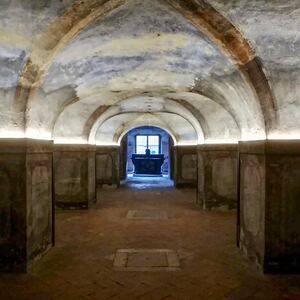Health
Secrets of Milan’s Historic Hospital Unearthed in Crypt Research

A crypt beneath the Ospedale Maggiore in central Milan has revealed critical insights into the lives of the city’s impoverished patients from the 17th century. Between the years of 1637 and 1693, approximately 10,000 corpses were interred in this underground resting place, which served as a final destination for many who passed through the hospital’s doors. Established by the Duke of Milan in 1456, Ospedale Maggiore, also known as Ca’ Granda or the Big Factory, aimed to provide care for the sick and injured, particularly the working poor of Milan.
Historians are now examining the significance of this facility, identified as Europe’s first secular hospital. According to Folco Vaglienti, a historian at the University of Milan, “Unlike the religiously affiliated institutions of the time, it welcomed people of any ethnicity or religion, marking a significant shift to a more universal approach to healing.”
Uncovering the Past
In 2018, a research team led by bioarchaeologist Mirko Mattia began an extensive analysis of the remains found within the crypt. This exploration aims to provide a clearer picture of the health conditions and societal challenges faced by the residents of Milan during this era. The research team meticulously sifted through the remains, seeking clues about the lifestyle, health issues, and mortality rates of the patients who sought assistance at Ospedale Maggiore.
The findings from this crypt are expected to contribute not only to historical knowledge but also to a better understanding of public health systems in early modern Europe. By examining skeletal remains, researchers can uncover details regarding nutrition, diseases, and overall health trends among the city’s vulnerable populations.
Significance of Historical Context
The establishment of Ca’ Granda marked a pivotal moment in healthcare history. Its secular nature allowed it to operate independently of religious doctrine, which was the norm for hospitals of that time. This shift indicated a broader acceptance of healthcare as a fundamental human right, rather than a privilege tied to religious affiliation.
The crypt serves as a poignant reminder of the struggles faced by the urban poor in Milan centuries ago. As the research progresses, the data gathered could offer invaluable insights into the evolution of medical care and public health policies in contemporary society. By understanding the historical context, modern healthcare systems may find inspiration in the compassionate and inclusive model that Ospedale Maggiore once represented.
As researchers continue to unveil the secrets held within the crypt, the legacy of Milan’s pioneering hospital stands to influence both historical scholarship and modern discussions about healthcare equity. The work of Vaglienti, Mattia, and their team not only honors the memory of those who sought care but also reinforces the enduring importance of accessible healthcare for all.
-

 World3 months ago
World3 months agoTest Your Knowledge: Take the Herald’s Afternoon Quiz Today
-

 Sports3 months ago
Sports3 months agoPM Faces Backlash from Fans During Netball Trophy Ceremony
-

 Lifestyle3 months ago
Lifestyle3 months agoDunedin Designers Win Top Award at Hokonui Fashion Event
-

 Sports3 months ago
Sports3 months agoLiam Lawson Launches New Era for Racing Bulls with Strong Start
-

 Lifestyle3 months ago
Lifestyle3 months agoDisney Fan Reveals Dress Code Tips for Park Visitors
-

 Health3 months ago
Health3 months agoWalking Faster Offers Major Health Benefits for Older Adults
-

 World3 months ago
World3 months agoCoalition Forms to Preserve Māori Wards in Hawke’s Bay
-

 Politics3 months ago
Politics3 months agoScots Rally with Humor and Music to Protest Trump’s Visit
-

 Top Stories3 months ago
Top Stories3 months agoUK and India Finalize Trade Deal to Boost Economic Ties
-

 World3 months ago
World3 months agoHuntly Begins Water Pipe Flushing to Resolve Brown Water Issue
-

 Entertainment3 months ago
Entertainment3 months agoExperience the Excitement of ‘Chief of War’ in Oʻahu
-

 Science3 months ago
Science3 months agoNew Interactive Map Reveals Wairarapa Valley’s Geological Secrets









